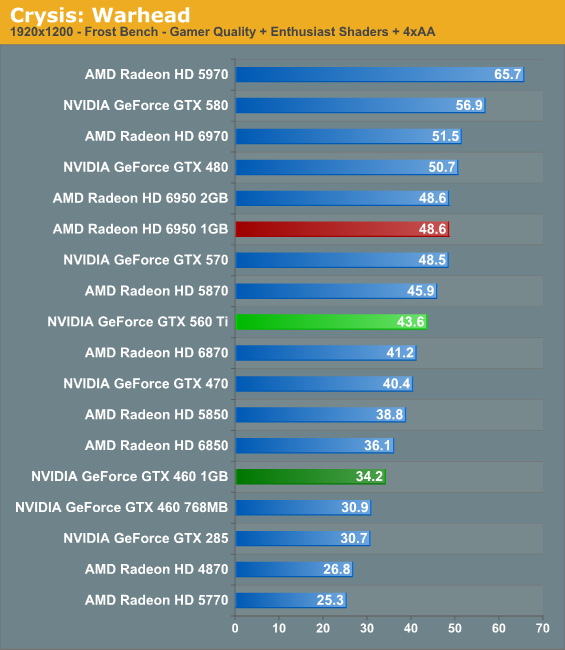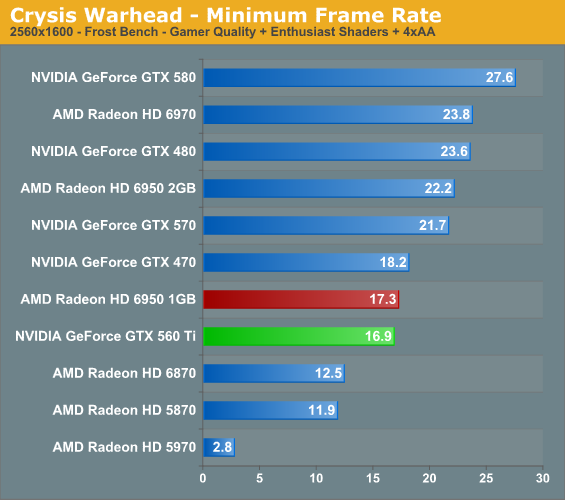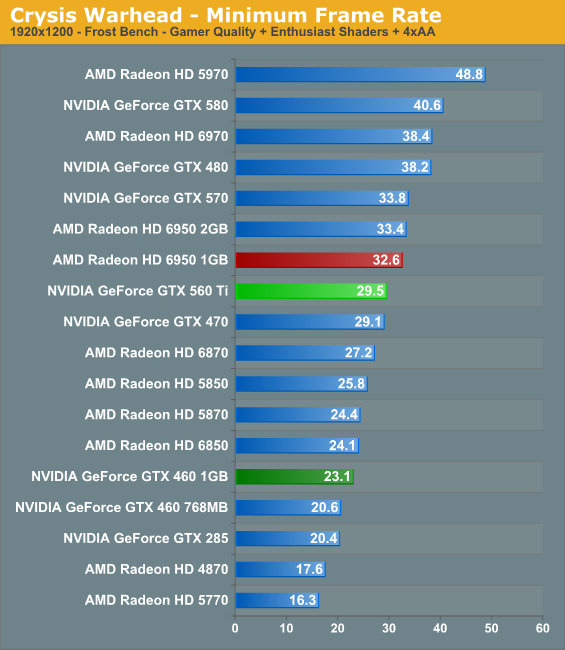NVIDIA's GeForce GTX 560 Ti: Upsetting The $250 Market
by Ryan Smith on January 25, 2011 9:00 AM ESTCrysis: Warhead
Kicking things off as always is Crysis: Warhead, still one of the toughest game in our benchmark suite. Even 2 years since the release of the original Crysis, “but can it run Crysis?” is still an important question, and the answer continues to be “no.” While we’re closer than ever, full Enthusiast settings at a playable framerate is still beyond the grasp of a single card.



While we throw in our 2560x1600 charts for good measure, the real chart to keep an eye on is at 1920x1200, the kind of resolution cards around this price range are targeted at. With that in mind, our first game – and often a prognostic of overall performance – is not in NVIDIA’s favor. The 6950 does quite well here, leaving the GTX 560 down by well more than the 4% price difference between the cards. Overall we’re looking at performance fairly close to the older 5870 in Crysis.
Amidst NVIDIA’s own stable of products, what becomes clear is that the GTX 560 has a close peer in the soon to be phased out GTX 470. At 1920 and 1680 the GTX 560 is always faster than the GTX 470, but never immensely so; and at higher resolutions the GTX 470 still has an advantage. Meanwhile the GTX 460 1GB is outclassed by a consistent 28%. It’s not bad for what’s technically the same GPU, eh?



The story of minimums is even a bit more lopsided against NVIDIA here. The lower the resolution the more it falls behind the 6950 1GB, by 15% at 1920 and 25% at 1680. However on a positive note, on an absolute basis the 560 is doing pretty well here; at 29.5fps minimum at 1920, it’s basically never falling below 30fps, meaning not only can it play Crysis but that it can do so smoothly. It is quite interesting to note though that the 560’s minimums are almost identical at 1920 and 1680, indicating a non-resolution dependent bottleneck. ROPs and/or memory bandwidth look to be the culprit here, particularly with the GTX 460 1GB coming so close at 1680.










87 Comments
View All Comments
Nimiz99 - Tuesday, January 25, 2011 - link
One of my buddies has a C2D 8500 system OC'd to 3.5 i think. He got himself a 5870 (overclocked) to game. The problem we ran into was that the C2D is too slow to handle games like Civ5 that heavily rely on the CPU to keep up (you can still play the game, but it's literally wasting the 5870 with noticeable lag from the chip). Basically, he is upgrading now to a sandy bridge. I'd wager some of the older i7's or maybe even a Thuban (OC'd to 3.8 with a good HT overclock) could manage, but why bother when a new architecture is out form Intel (or AMD later in the year).So enjoy your new build ;),
Nimiz
Beenthere - Tuesday, January 25, 2011 - link
Over the last couple years Nvidia has really struggled and they may be on the ropes at this point. They have created a lot of their own problems with their arrogance so we'll see how it all plays out.kilkennycat - Tuesday, January 25, 2011 - link
eVGA GTX560 Ti "Superclocked" Core: 900MHz, Shader 1800MHZ; Memory 4212MHz $279.99~ 10% factory-overclock for $20 extra, together with a lifetime warranty (if you register within 30 days) ain't too shabby....
Belard - Tuesday, January 25, 2011 - link
Sure, the name shouldn't be a big deal... but each year or worse, Nvidia comes up with a new marketing product name that is meaningless and confusing.Here is the full product name:
GeForce GTX 560 Ti But in reality, the only part that is needed or makes ANY sense is:
GeForce 560
GTX / GT / GTs are worthless. Unless there were GTX 560, GTS 560 and GT 560. Much like the older 8800 series.
TI is only added to this idiotic mess. Might as well Ultra, Pro or MX.... so perhaps Nvidia will come out with the "GT 520 mx"?
The product itself is solid, why turn it into something stupid with your marketing department?
AMD does it right (mostly), the "Radeaon 6870" that's it. DUH.
omelet - Tuesday, January 25, 2011 - link
Yeah. Not that it really matters. And while this might be what you meant by "mostly" note that AMD's naming was pretty retarded this generation with the 68xx having lower performance than 58xx.But I don't see why they readopted the Ti moniker.
Sufo - Wednesday, January 26, 2011 - link
no, that's only a result of the 5xxx series being stupidly named. Using 5970 for a dual chip part was the error. Use an x2 suffix or smthng. AMD is back on track with the 6xxx naming convention... well, until we see what they do with the 6 series dual chip card.Belard - Thursday, January 27, 2011 - link
The model numbers of:x600, x800, etc have been consistent since the 3000 series.
x800 is top
x700 is high-end mid range ($200 sub)
x600 is mid-range ($150 sub)
x400~500 low-end ($50~60)
x200~300 Desktop or HTPC cards.
AMD said they changed because they didn't want to confuse people with the 5750/5770 cards with the 6000 series. Which is completely stupid... so instead they confuse everyone with all th cards.
If the 6800s were called 6700s - they would have been easily faster than any of the 5700s and at least somewhat equal to the 5800s (sometimes slower, others faster). Instead, we have "6850" that is slower than the 5850.
The prices are a bit high still, yet far cheaper than the 5800 series, in which a 5850 was $300+ or $400 for the 5870. But by all means, I'd rather spend $220 on a 6870 than $370 on todays 5870s.
Anyways, I'm still using a 4670 in my main computer. When I do my next upgrade, I'll spend about $200 at the most and want at least 6870 level of performance, which is still about 4x faster than what I have now. Noise & heat are very high on my list, my 4670 was $15 extra for the better noise & heat cooling system. Perhaps in 6 months, the AMD 7000 or GeForce 700 series will be out.
marraco - Tuesday, January 25, 2011 - link
Is the first time I see a radiator geometrically aligned to the direction of air velocity thrown by the fan.Obviously it increases the efficiency of the fan, increasing the flow of air thrown across the radiator, and reducing noise.
It’s an obvious enhancement in air cooling, that I don’t understand why CPU coolers don’t use.
strikeback03 - Tuesday, January 25, 2011 - link
I wouldn't be surprised if in some cases the increase in fin surface area (from having a bunch of straight fins packed more closely together) produces better cooling than having a cleaner airpath.MeanBruce - Wednesday, January 26, 2011 - link
You should check out the four Asus Direct CU II three slot radiators that came out today on the GTX 580, 570, and the HD 6970 and 6950, each using two 100mm fans, five heatpipes and three slots of pure metal, they claim you can easily fit two of them on ATX for SLI and CB?